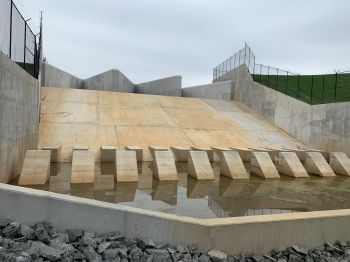Spillways

|
| Labyrinth weir spillways are commonly used to increase discharge capacity at existing dams.
(Image Source: Gannett Fleming) |
“The basic purpose of the spillway is to provide a means of controlling the flow and providing conveyance from reservoir to tailwater for all flood discharges up to the spillway design flood (SDF). The spillway can be used to provide flood control regulation for floods either in combination with flood control sluices or outlet works, or in some cases, as the only flood control facility.[1]
“One of the most common causes of dam failures is the inability to safely pass flood flows. Failures caused by hydrologic conditions can range from sudden failure, with complete breaching or collapse of the dam, to gradual failure, with progressive erosion and partial breaching”.[2]
“Crest piers, abutments, and approach configurations of a variety of shapes and sizes have been used in conjunction with spillways… Not all of the designs have produced the intended results. Improper designs have led to cavitation damage, drastic reduction in the discharge capacity, unacceptable waves in the spillway chute, and harmonic surges in the spillway bays upstream from the gates. Maintaining the high efficiency of a spillway requires careful design of the spillway crest, the approach configuration, and the piers and abutments. For this reason, when design considerations require departure from established design data, model studies of the spillway system should be accomplished”.[1]
Anatomy of a Spillway
Types of Spillways (Classified by Operation)
Types of Spillways (Classified by Function)
See also: Hydraulics > Hydraulic Performance of Spillways
Examples
Best Practices Resources
![]() Selecting and Accommodating Inflow Design Floods for Dams (FEMA P-94), FEMA
Selecting and Accommodating Inflow Design Floods for Dams (FEMA P-94), FEMA
![]() Technical Release 210-60: Earth Dams and Reservoirs, NRCS
Technical Release 210-60: Earth Dams and Reservoirs, NRCS
![]() Design Standards No. 14: Appurtenant Structures for Dams (Ch. 1: Introduction), USBR
Design Standards No. 14: Appurtenant Structures for Dams (Ch. 1: Introduction), USBR
![]() Hydrologic Engineering Requirements for Reservoirs (EM 1110-2-1420), USACE
Hydrologic Engineering Requirements for Reservoirs (EM 1110-2-1420), USACE
![]() Hydraulic Design of Spillways (EM 1110-2-1603), USACE
Hydraulic Design of Spillways (EM 1110-2-1603), USACE
Trainings
![]() ASDSO Dam Owner Academy: Spillways & Outlet Works
ASDSO Dam Owner Academy: Spillways & Outlet Works
![]() On-Demand Webinar: Inspection and Assessment of Spillways
On-Demand Webinar: Inspection and Assessment of Spillways
![]() On-Demand Webinar: Introduction to Addressing Inadequate Conveyance Capacity at Dams
On-Demand Webinar: Introduction to Addressing Inadequate Conveyance Capacity at Dams
![]() On-Demand Webinar: Hydraulics 101: Intro to Hydraulics for Dam Safety
On-Demand Webinar: Hydraulics 101: Intro to Hydraulics for Dam Safety
![]() On-Demand Webinar: Hydraulics 201 for Dam Safety
On-Demand Webinar: Hydraulics 201 for Dam Safety
![]() On-Demand Webinar: Inlet and Outlet Hydraulics for Spillways and Outlet Structures
On-Demand Webinar: Inlet and Outlet Hydraulics for Spillways and Outlet Structures
![]() On-Demand Webinar: Designing Spillways to Mitigate Failure Modes
On-Demand Webinar: Designing Spillways to Mitigate Failure Modes
Citations:
Revision ID: 7471
Revision Date: 07/28/2023
